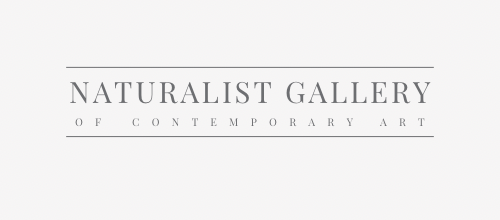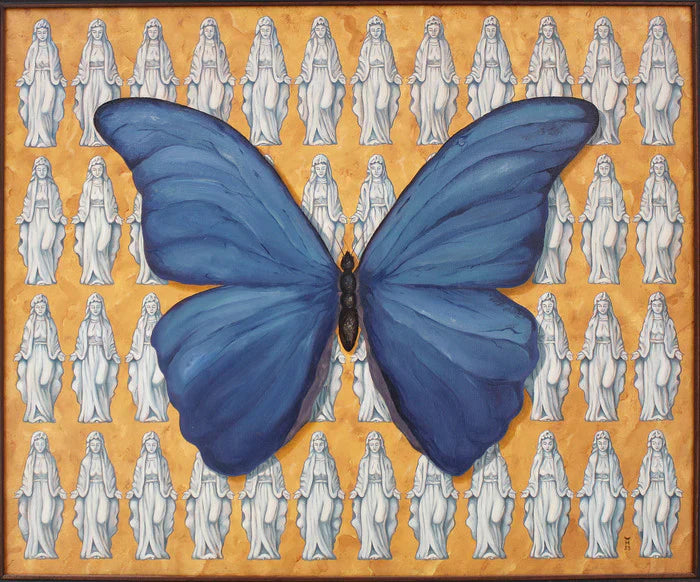Featured image: Sacré Bleu, Howard Hastie, 2023, oil on canvas, 28 x 34 in. / 71.12 x 86.36 cm.
Howard Hastie’s latest series offers a sly, intricate dive into contemporary mysticism and myth, blending sacred iconography, internet-age irony, and pattern-driven visual logic.
Howard Hastie weaves sacred symbolism, surreal imagery, and ironic cultural critique into richly detailed oil paintings that challenge modern systems of meaning.
Through ornate oil paintings framed by tile motifs, Hastie’s work straddles the line between satire and sincerity, using beauty and repetition to question the value systems we’ve inherited or invented. These three pieces, Chakra Balderdash, Numerology 6, and The Big Apple, form a quiet but biting triptych on belief, both personal and collective.
Explore our curated selection of contemporary artists from around the globe.
Naturalist Gallery offers artist representation internationally. Apply your art.
Chakra Balderdash, Howard Hastie, 2024, oil on canvas, 28 x 34 in. / 71.12 x 86.36 cm.
In Chakra Balderdash (2024), Hastie presents a hypnotic woodgrain swirl that doubles as a visual Rorschach test. The symmetrical forms evoke faces, bodies, demons, depending on the viewer’s mood. Surrounding the central mass is a tile-like border adorned with zodiacal symbols, arranged with precision but offering no clear pattern or sequence. The result is an anti-mandala: a meditation on chaos masquerading as order, critiquing the commercialization of esoterica and the randomness underlying systems we pretend are divine.
Numerology 6, Howard Hastie, 2024, oil on canvas, 28 x 34 in. / 71.12 x 86.36 cm.
Numerology 6 (2024) offers a symbolic twist on sacred motherhood, embedding a Madonna and Child into the folds of a blooming ivory flower. Tiny green leaves float like spirits, and faux-stained-glass corner icons amplify the religious overtone. Yet Hastie’s figures are human, tired, grounded, nearly modern in expression. It’s a tender subversion: reverent of archetypes, skeptical of deification. The number six, often associated with harmony and care, floats quietly behind the piece’s layered message.
The Big Apple, Howard Hastie, 2020, oil on canvas, 33 x 24 in. / 83.82 x 60.96 cm.
The Big Apple (2020) channels classic surrealism with a contemporary edge. A central red apple sits untouched before a group of robed, faceless figures. Behind them, a cathedral-like balcony opens to pastoral light, flanked by emoji thumbs-ups and what appears to be a smartphone app icon above the apple. Hastie builds tension between spiritual elevation and social media flattening. The apple, once a biblical symbol, is now just a branded temptation, surveyed by an algorithmic god.
Together, these works form a philosophical puzzle: each painting questions faith, order, and the digital sacred with sly visual riddles. Hastie invites viewers not to decode, but to dwell, among contradictions, symbolism, and manufactured awe.
Learn more About Naturalist Gallery of Contemporary Art.
Peaches and Cream, Howard Hastie, 2024, oil on canvas, 28 x 34 in. / 71.12 x 86.36 cm.
You may also find the following articles helpful:
The 14 Essential Artists of Impressionism
Expressionism: 20 Iconic Paintings & Their Artists
Renaissance Art: Origins, Influences, and Key Figures
Classical Art Movement: Exploring the History, Artists, and Artworks
Figurative Art: Understanding, Collecting, and Appreciating the Style
Daily Routines of Famous Artists: Learn from the Masters
Top 12 Controversial Artworks That Changed Art History





